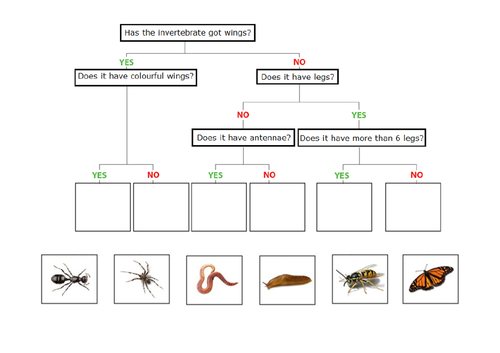








In this first lesson pupils should be taught to:
• Recognise that living things can be grouped in a variety of ways
• Use a keys, tables and diagrams to help group animals
• Identify and name a variety of living things from their local and wider environment
The following summary is based on notes and guidance from the National Curriculum.
The pupils will be classifying living things and presenting data in a variety of ways to help in answering questions, discussing their findings with peers and the staff. Instead of using written methods, discussion could also be assessed whilst the students complete the grouping of invertebrate and vertebrate table to gain an understanding of their knowledge. A snowball activity could be used where one pupil remains by their work and the other moves around the room. The student that stays can discuss why they have placed each animal either in the vertebrate column or the invertebrate column.
The pupils have the opportunity to group and classifying invertebrate species by observing and recording the features of a range of invertebrate species. I like to take the students to an area on the school grounds where they can collect and observe living organisms. The students can use pooters to prevent harm to the organisms and use small containers with holes to collect them for their observations in the classroom. Magnifying glasses are another good resource to use, so the students can observe the organisms in more detail. They can complete the garden detectives sheet and the fact files sheet during the investigation or when they return to the classroom. The students can also be given the chance to work independently by finding out more facts using secondary sources of information which have been provided.
The resources can be used as a stimulus to talk about criteria for grouping, sorting and classifying. They should begin to look for naturally occurring patterns and relationships between animals that share similar features.
Pupils should explore possible ways of grouping a wide selection of vertebrate species using the classification key. The Venn diagrams are a resource to assess the pupils knowledge and for them to record the similarities and differences between different invertebrate groups. There is one for a summary that gets the students to compare invertebrates and vertebrates. The activities have been specifically designed to provide the scaffolding needed for pupils to discover invertebrate groups such as snails, slugs, worms, spiders and insects
The students will record their findings using simple scientific language and by completing keys and tables.
Something went wrong, please try again later.
This resource hasn't been reviewed yet
To ensure quality for our reviews, only customers who have purchased this resource can review it
Report this resourceto let us know if it violates our terms and conditions.
Our customer service team will review your report and will be in touch.